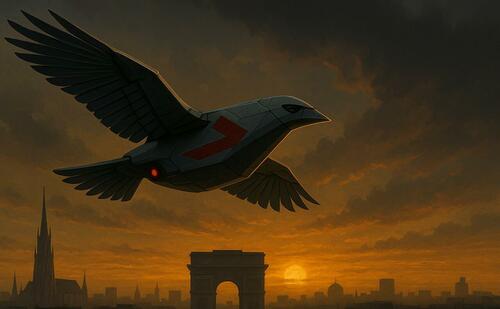Feathers, Fences, and Folly: The EU’s Drone Wall Disaster
The EU’s proposed “Drone Wall” to shield its eastern borders from external threats has become a darkly comic symbol of bureaucratic excess, military profiteering, and Europe’s growing detachment from geopolitical and economic realities.
After over a decade of geopolitical comedy and errors, the recent news that NATO and the EU’s unelected Fuhrer intend to build a so-called “Drone Wall” to protect the bloc’s Eastern flank is crazy. What seems like a knee-jerk reaction by the NATO mob is, in reality, a well-planned money game. The fact that these leaders think the general public is this uninformed demands a sardonic response.

An Alfred Hitchcock Policy
When Ursula von der Clucky announced Europe’s grand new bulwark against “malign influence”—the mighty Drone Wall from the Baltic to the Black Sea—Brussels brochures showed smiling engineers and schematic ribbons. The fine print? A total war on anything that flapped. In my mind, I see missiles worth hundreds of thousands being launched at horrified birds. Avians, the EU caricatures, should pray they don’t fight back like those in the Hitchcock horror “The Birds.”
I can see it now; the first test went about as well as a soufflé in a thunderstorm. Within days, a million birds had been mistakenly gunned out of the sky over Poland and Romania. Ornithologists cried; farmers mourned; the PR people called it “avian recalibration.” McDonald’s quietly introduced the EuroBird Special and blamed supply chain issues.
Laugh if you like, but the military-industrial complex smiled all the way to the procurement office. Every feather shot down bought a new radar upgrade, a new fence contract, and a new consulting retainer. Enter the Sky Sparrow—China’s latest invisible ornithopter, a tiny biomimetic drone that flaps like a swallow and slips past standard radar signatures. To a bureaucrat’s motion sensor, it is indistinguishable from a migrating stork. To a lobbyist’s checkbook, it is a miracle.
The Wall’s first embarrassment was relatively polite. The Sky Sparrow dropped biodegradable leaflets of promotional propaganda—a marketing campaign in feathers. The Wall shot at flocks. The Wall missed the point. And not just the fact the impenetrable Drone Wall does not encircle all of Europe.
Peskov’s Daily Brief
Meanwhile, Moscow’s strategic planners chuckled over tea. Vladimir Putin’s right-hand man sets the headline on the Russian leader’s desk, trying to constrain himself from laughing out loud and spoiling the joke. “Now what?” Putin quizzes Peskov. If Europe wants to build monuments to fear, fine. The real question was not whether Russia could punch through a fence of sensors. The real question was political: who will still have bread when the winter comes?
Millions of EU service-sector workers had already lost jobs in the trade-and-sanctions cascade that followed the 2014 Kyiv change of government and the subsequent years of economic countermeasures. Manufacturing lines had shifted east; farms felt the squeeze of high energy and fertilizer prices. Nations where services made up more than 70% of GDP were suddenly fragile in a way the preppers on social media loved to explain—and the rest of the continent did not.
Across the Mediterranean, opportunists smelled theater. Whispers—half rumor, half strategic fantasy—began to circulate in bars and briefing rooms: suppose a belligerent actor launched a second wave of tiny spy-ornithopters from unexpected bases, say, from Algerian waters or from other third-party airspace behind the Wall. Small, birdlike, and launched from behind the curtain, these drones could sketch routes, test responses, or simply embarrass a continent that had spent billions to protect itself from cartoons.
That is the delicious, cruel geometry of modern conflict: build a wall to keep the enemy out, and give the enemy new angles to perform in. Russia could always say it was a rogue contractor—or a weather balloon. Ursula would call an emergency summit, order a new committee, and two billion euros would change hands. The Wall would be upgraded. The birds would be replaced with newer birds. The headlines would cycle.
The EU: Dead On the Wings of Doves
As for the people, the numbers tell the blunt tale: services-heavy economies have fewer redundancies when fields fail and factory lines stop. Food is not something you can digitize on demand. The nations with more balanced GDPs—agriculture, mining, and manufacturing—will weather an embargo better than a country that trades in boutique hotels and festival VAT.
So the scene plays out like a tragicomedy:
- Brussels builds a Wall to guard tourists, hospitals, and accountants.
- Contractors make fortunes, birds make fewer flights, and citizens get pamphlets about preparedness.
- China markets the Sky Sparrow as progress.
- Someone somewhere tests launching tiny spy-ornithopters from behind the Wall as a practical joke that costs a continent credibility.
- Russia watches, amused; Moscow’s strategists count food bins, not feathers.
The official slogan—KEEP CALM AND PREPARE—now sounds like a polite request from a government that has run out of other options. The Wall stands, a ribbon of sensors and smoked glass and multibillion euro surface-to-air weapons, and the birds move eastward. They choose, for once, where to land.
And Ivan the fisherman, who never read a policy paper in his life, pours a glass, watches a tiny drone bob like a swallow over the harbor, and says, “Build walls if you must. But don’t be surprised when the sky finds new doors.”
This article was published previously on New Eastern Outlook


